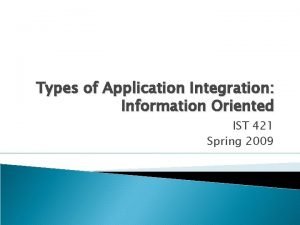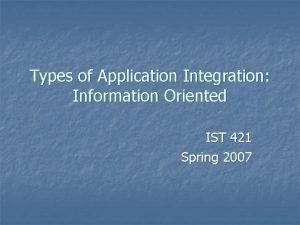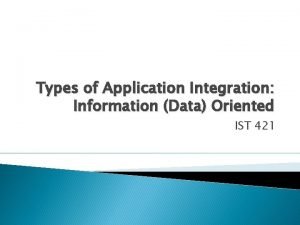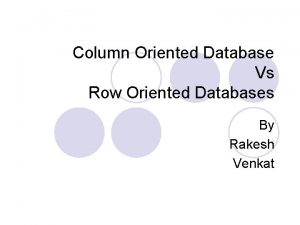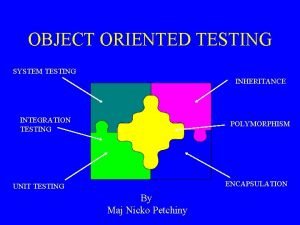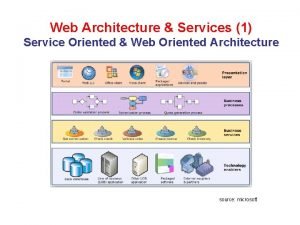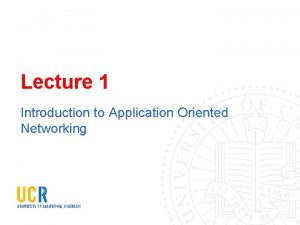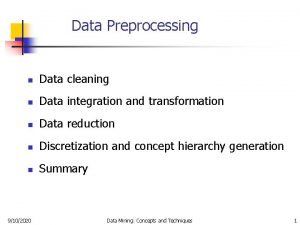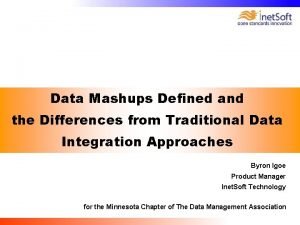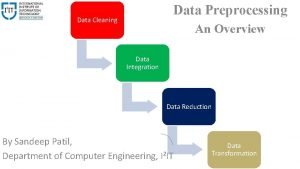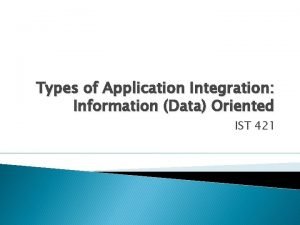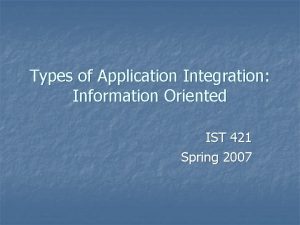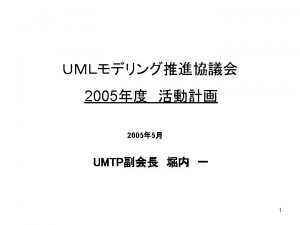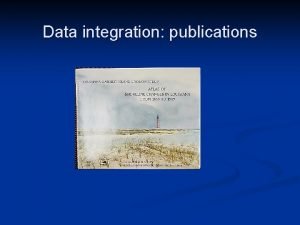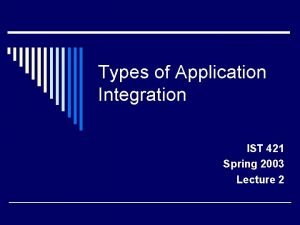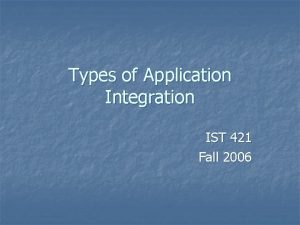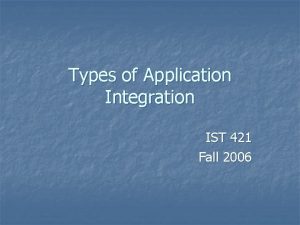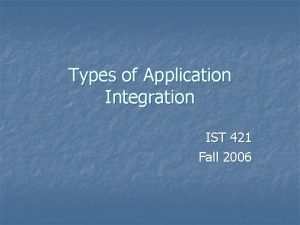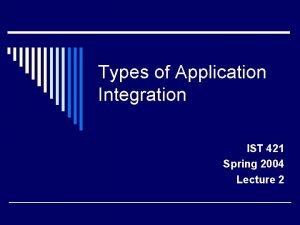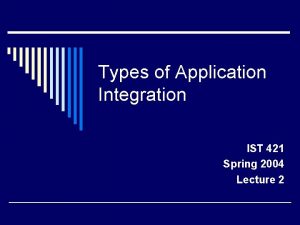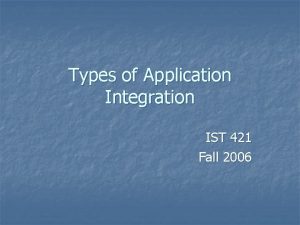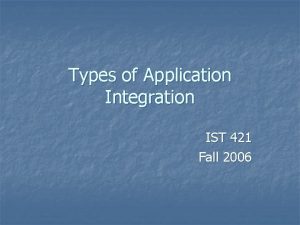Types of Application Integration Information Data Oriented IST




















- Slides: 20

Types of Application Integration: Information (Data) Oriented IST 421

Information Systems are a network of heterogeneous information sources over which various complex business procedures are executed.

Integration Models There are four general categories to consider for integration: ◦ ◦ Information (data)-oriented Business process integration-oriented Service-oriented Portal-oriented

Information-Oriented A simple mechanism to exchange information between two or more systems. Data could come from ◦ a database ◦ an API (i. e. SAP) ◦ an imbedded device Dealing with simple information, not with processes or application services

Data-Level Integration

Information-Oriented Problem domains: ◦ Moving data between traditional mainframe, fileoriented databases and relational databases ◦ Relational databases to object databases ◦ Multi-dimensional databases to mainframe databases ◦ Unstructured Content Integration Documents, audio, video & graphic files

Information-Oriented Source and Target systems produce and consume information Extract, Transform, and Load (ETL) tools Pattern follows: ◦ ◦ Database (SQL or JDBC) Application (API) User interface (Screen scraping) Embedded device (API type interface)

Database Pattern Databases are natural points of integration because they were designed to produce and consume data Interact with databases using SQL or through a Call-Level Interface (CLI) such as Java Database Connectivity (JDBC) When using SQL, database responds with result set ◦ Can be one or many records

Application Patterns Application interfaces are much more complex than databases because they consume and produce information differently Applications don’t share common patterns or standards; need to address each packaged application individually Application interfaces are interfaces that developers expose from packaged or custom applications to gain access

Application Patterns Some interfaces allow access to business processes only Some interfaces allow access directly to the data Packaged applications include products like SAP, People. Soft, Oracle, and Siebel Effort to standardize application interfaces using J 2 EE Connectivity Architecture (JCA) and Web services.

Application Patterns Example: Get. Invoice. Information(“ 12345”) <BOM> John Smith 222 Main Street Smalltown, VA 88888 Invoice Number: 12345 001 Red Bricks 1000. 50 500. 00 <EOM>

User Interface Patterns Leveraging the user interface as a point of information integration is a process known as “screen scraping. ” Problem is that a user interface was never designed to serve up data This type of solution can’t scale Use with closed or proprietary applications Should be at the bottom of the list of solutions

Embedded Device Patterns Embedded device might be a temperature sensor, call-counting machine, or a wireless device Common pattern is the fact that information must flow freely from the device

When to Use it Combine data from multiple sources for analysis and decision making Provide multiple applications with read access to a common source of information Allow data to be extracted from one source and reformatted and updated in another

Data-Level Integration Advantages: ◦ Tools and techniques currently exist ◦ Relatively easy and in wide use ◦ Requires no changes to the application logic or database structure ◦ Provides access to a wider range of simple data ◦ Allows data to be reused across other applications ◦ Techniques have been in use for over 30 years

Data-Level Integration Disadvantages: ◦ Need to rewrite business logic ◦ Need to understand application semantics between source and target systems

Information Integration solution set that works: ◦ Identify the data ◦ Catalog the data into a data dictionary Reason for the data Ownership Format Security Role in the data structure ◦ Build the enterprise metadata model Used as a master guide for integrating

Information Integration Maintain integrity issues Data latency ◦ Real time ◦ Near time ◦ One time

Information Integration

Information Integration Solution might include: ◦ Database replication ◦ Translation software ◦ Message brokers Tie all source and target databases together cohesively, without requiring changes to connected databases or application logic.
 Portal-oriented application integration
Portal-oriented application integration Information oriented application integration
Information oriented application integration Information-oriented examples
Information-oriented examples Trade-oriented sales promotion
Trade-oriented sales promotion What is a column row db
What is a column row db Winter kommt flocken fallen nieder
Winter kommt flocken fallen nieder Winter kommt winter kommt flocken fallen nieder
Winter kommt winter kommt flocken fallen nieder Klassendienst
Klassendienst Es ist herbst bunte blätter fliegen
Es ist herbst bunte blätter fliegen Zu glauben ist schwer. nichts zu glauben ist unmöglich
Zu glauben ist schwer. nichts zu glauben ist unmöglich Object oriented integration and system testing
Object oriented integration and system testing Service oriented web application
Service oriented web application Consumer oriented e commerce application
Consumer oriented e commerce application Application oriented networking
Application oriented networking Etl in data cleaning and preprocessing stands for
Etl in data cleaning and preprocessing stands for Data mashups and gis are data integration technologies.
Data mashups and gis are data integration technologies. Data mashups and gis are data integration technologies.
Data mashups and gis are data integration technologies. Entity identification problem in data integration
Entity identification problem in data integration Three dimensions of corporate strategy
Three dimensions of corporate strategy Xiaomi bcg matrix
Xiaomi bcg matrix What is simultaneous integration
What is simultaneous integration
